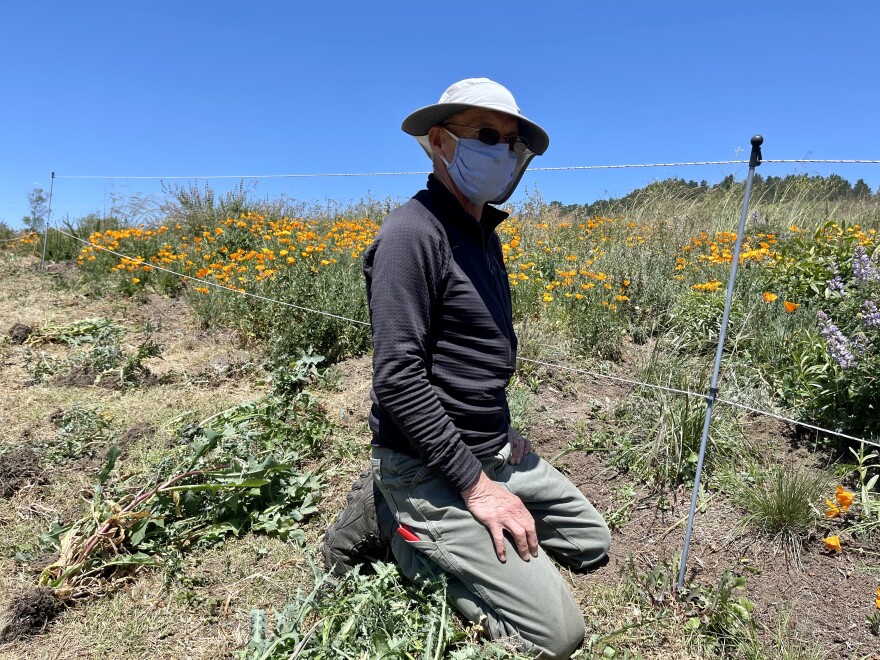The western monarch butterfly is in trouble. This past winter, fewer than 2,000 monarchs were counted in California, which represents a 99% percent decline in their population since the 1980s. But a hopeful spring is following a winter of doom and gloom. Congress has taken up their plight through legislation and there’s something you can do now — take a hard look at your garden.
For inspiration, check out the gardens at Palo Corona Regional Park in Carmel. Nearly 200 acres of the 4,700-acre park, which offers hiking trails that meander along the Carmel River, used to be a golf course. Three years ago, the Monterey Peninsula Regional Park District obtained the course.
Returning the once manicured fairways back to its natural beauty has been hard work. Restoration included the creation of four native gardens. The one near the entrance to the park is an acre big. It’s golden grasses, California poppies and bush lupine are great examples of native plants that can help monarch butterflies thrive. In fact, the garden, which started out as a test plot to see which plants thrive, has become a monarch breeding habitat.
“I look at this landscape and I think about what it used to be and how it’s been used over time and I feel empowered,” said Jackie Nelson, the environmental education supervisor with the park district.

Behind the native gardening work is biologist and volunteer gardener Scott Hennessy. At least once a week he comes out to care for the garden, which is home to about 10,000 native plants that are important for local pollinators, including the monarch butterfly.
“There’s narrow leaf milkweed and it's from a local seed stock not even 10 miles from here,” said Hennessy.
Milkweed is vital for monarchs. It’s what they lay their eggs on and it’s the only plant monarch caterpillars eat. Hennessy spots one munching on a milkweed plant.
“It is wonderful. I came here months ago and was just pulling weeds and suddenly saw some of the larvae and I hadn’t anticipated them being here,” he said.

About six monarch caterpillars have been spotted in the garden so far this spring. For citizen scientist Connie Masotti, it’s a hopeful sign. She’s spent the past decade collecting data on monarchs. Recently, her work hasn’t been easy because the butterflies’ numbers have dropped sharply. This winter was particularly bad; zero monarchs showed up to the beloved sanctuary in the nearby coastal town of Pacific Grove, known as Butterfly Town, U.S.A. The sanctuary is an “overwintering site,” a place where monarchs come to spend the cold months. Five winters ago, Masotti counted 17,000 monarchs there.
“To not see any, I would sit in my car and cry after the counts. It was sad,” she said.
Still, Masotti is working toward a brighter future. She gives talks on how people can lend a helping hand, starting right in their backyards this spring. Masotti says one of the best ways to help monarchs is to plant native. She compares exotic plants to junk food for local pollinators because they lack nutrition.
“It's going to have to change some hearts and minds of how we were always raised to think this was a good yard,” said Masotti. “No, it's not really.”

When it comes to gardening for monarchs, location matters. If you live within five miles of the coast north of Santa Barbara or five miles from an overwintering site, put in native nectar plants. Monarchs need nectar for fuel during their winter stay. (Click here for a map of overwintering sites.)
If you live inland, you can plant both native nectar sources, and importantly,native milkweed. That’s needed for breeding, which usually occurs between March and September. (Click here for a list of nectar plants that are native to California and when to plant them.) If possible, buy plants from nearby nurseries that don’t use pesticides.
Pesticides, climate change and habitat loss are the largest threats to monarchs, according to the Xerces Society, an international nonprofit, which is dedicated to invertebrate conservation.
“We’re losing overwintering habitat to a variety of different things, but it’s mostly development, tree trimming and wildfires,” said Endangered Species Conservation Biologist Sarah McKnight with Xerces.
The Xerces Society has been working with local U.S. Congressman Jimmy Panetta to save monarchs from extinction through new legislation. Panetta says the bills are personal to him. He remembers visiting local monarch sanctuaries as a child.
“When I was a kid, you would go there and literally be swimming in butterflies,” Panetta said.
Panetta’s two bills are the MONARCH Act (Monarch Action, Recovery, and Conservation of Habitat Act) and the Monarch and Pollinator Highway Act. The first bill would provide $125 million in funding to implement the Western Monarch Butterfly Conservation Plan and help protect and restore habitat.
“It will invest in education, conservation, scientific research programs, and then it will track population trends and threat reduction efforts for the western monarch butterfly,” he said.
The second would establish grants for transportation agencies and Native American tribes to plant native grasses and wildflowers along roadways.
As Panetta takes on the plight of monarchs in Washington, D.C., the gardening work continues at Palo Corona park in Carmel to help monarchs thrive. Despite the rapid decline of these butterflies, citizen scientist Connie Masotti hasn’t given up.
“No, it is not too late. It is never too late as long as there's one monarch out there,” she said.
Check out “100 Plants to Feed the Monarch” by the Xerces Society for tips on creating a healthy habitat for monarchs — a favorite book of featured gardener Scott Hennessy.




